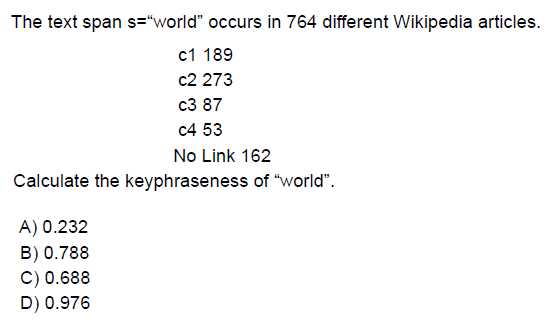Natural Language Processing Week 10 NPTEL Assignment Answers 2025
NPTEL Natural Language Processing Week 10 Assignment Answers 2024
1. Common Steps of Entity Linking are –
Options:
- A) Reference Disambiguation → Candidate Selection
- B) Reference Disambiguation → Candidate Selection → Mention Identify
- C) Mention Identify → Candidate Selection → Reference Disambiguation
- D) All of the above
✅ Answer: C
Explanation:
Entity Linking follows this correct order: Mention Identification → Candidate Selection → Reference Disambiguation.
2.

✅ Answer: B
3. What is the commonness of (s, c₂) in the above question?
Options:
- A) 0.765
- B) 0.389
- C) 0.453
- D) 0.910
✅ Answer: c
Explanation:
Commonness typically refers to the probability that a surface form s refers to candidate entity c₂.
4. Higher value of keyphraseness represents higher probability of:
Options:
- A) An article to get selected as linkable candidate
- B) A phrase to get detected as a mention
- C) An article to get disambiguated from other candidates
- D) None of the above
✅ Answer: b
Explanation:
Keyphraseness measures how likely a phrase is a named entity mention.
5. Which of the following problems exist in bootstrapping technique for Information Extraction?
Options:
- A) Sensitiveness towards the seed set
- B) High precision
- C) Less manual intervention
- D) All of the above
✅ Answer: a
Explanation:
Bootstrapping heavily relies on the quality and bias of the initial seed set, making it sensitive to errors.
6. Which of the following is an advantage of unsupervised relation extraction?
Options:
- A) Can work efficiently with small amount of hand-labeled data
- B) Not easily generalizable to different relations
- C) Need training data
- D) Always perform better than supervised techniques
- E) None of the above
✅ Answer: e
Explanation:
None of the above are advantages. Unsupervised relation extraction is hard to evaluate, often less accurate.
7. Which of the following is/are a Hearst’s Lexico-Syntactic Pattern for automatic acquisition of hyponyms?
Options:
- A) X or other Y
- B) X and other Y
- C) Y including X
- D) X but not Y
✅ Answer: a, b, c
Explanation:
Hearst patterns help extract hyponym-hypernym relationships. Examples include:
- “such as”,
- “including”,
- “and other”,
- “or other”.
8. Advantage of Distant Supervision over Bootstrapping method
Options:
- A) Need more data
- B) Less human effort
- C) Can handle noisy data better
- D) No Advantage
✅ Answer: c
Explanation:
Distant Supervision is more robust in handling noise, especially when labeled data is noisy or incomplete.
9. For a dataset with few but important relations, the most useful metric is:
Options:
- A) Precision
- B) Recall
- C) Accuracy
- D) F1-Score
✅ Answer: b
Explanation:
In scenarios where missing important relations is critical, Recall is prioritized to capture as many as possible.
10. Bootstrapping can be considered as:
Options:
- A) Supervised Approach
- B) Unsupervised Approach
- C) Semi-supervised Approach
- D) All of the above
- E) None of the above
✅ Answer: c
Explanation:
Bootstrapping starts with a small labeled set (supervised) and grows using unlabeled data, making it semi-supervised.

![[Week 1-12] NPTEL Natural Language Processing Assignment Answers 2025](https://answergpt.in/wp-content/uploads/2025/07/Natural-Language-Processing.png)

![[Week 1-12] NPTEL Natural Language Processing Assignment Answers 2024](https://answergpt.in/wp-content/uploads/2024/01/NPTEL-Natural-Language-Processing-Assignment-Answers-2024.jpeg)


